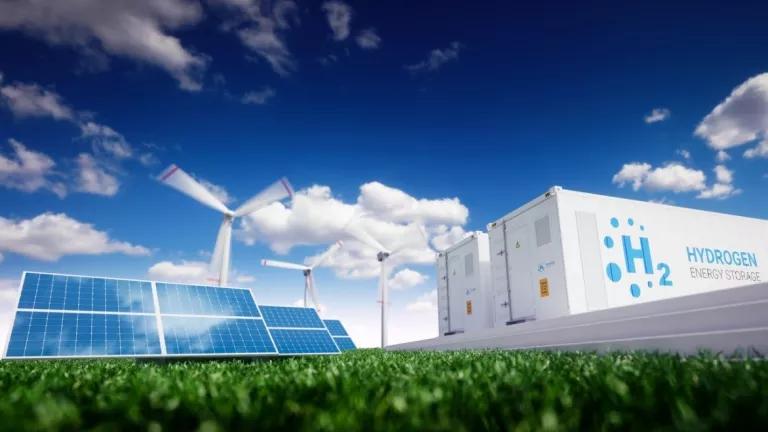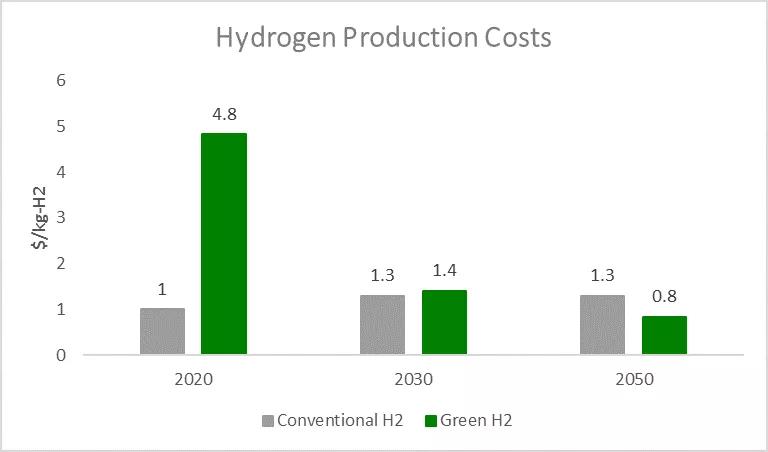“Green” Hydrogen: Critical to Powering a Carbon-Free Future

NRDC is increasingly engaged in discussions and analyses related to the role of green hydrogen in a clean economy. This blog is the start of a rolling series focused on our findings and thoughts.
To stave off the worst effects of the climate crisis, we must urgently transition from polluting fossil fuels to emissions-free energy. “Green” hydrogen is quickly emerging as a potential solution for the sectors most difficult to electrify from clean resources—such as aviation, marine shipping, and heavy industry—and could help us resolve some of the biggest challenges to a fully renewable electricity system.
Most U.S. hydrogen today is produced from fossil gas in a pollution-heavy process and mainly used in oil refining and the production of fertilizer. Fortunately, the process can be decarbonized by instead using water and renewable electricity to create “green hydrogen.” While it is currently more expensive to produce, significant cost reductions are projected worldwide—driven by ever-cheaper renewable energy and lower equipment costs.
Other countries already are realizing the potential. Germany recently afforded hydrogen the biggest chunk of its green stimulus funds; Japan and Korea are significantly increasing their hydrogen subsidies; and with billions of euros earmarked for deployment, the European Union’s recently proposed hydrogen strategy is projected to kick-start a global hydrogen economy. The United States could be following suit; the recently released House Climate Action Crisis Plan is peppered with recommendations to Congress to pass robust policies to scale up the hydrogen industry and green hydrogen projects are already being proposed.
The 2020s are a crucial decade to enable green hydrogen to be a part of the longer-term global effort. For example, projected cost reductions are contingent upon passing near-term policies to stimulate demand for green hydrogen and unlock learning and economies of scale. The U.S. Congress, policymakers, and stakeholders must start thinking about both the near and long-term policies needed today to unlock the green hydrogen potential.

Deus Ex Machina: A potential solution for hard-to-abate sectors
Two years ago, most viewed hydrogen as a negligible piece of the decarbonization story. But since then, the science shifted on the need to hold the increase in global warming to 1.5C rather than 2C to avoid the most catastrophic impacts of climate change. And with that, the global decarbonization target shifted to a greenhouse gas (GHG)-neutral economy by 2050 instead of an 80 percent reduction in GHGs.
Squeezing that last 20 percent in time makes all the difference due to what are known as the hard-to-abate sectors: aviation, shipping, heavy industry and long-haul trucking. Electrification—a key solution to decarbonizing much of the economy—is still being demonstrated for these sectors and will need to overcome a number of challenges in each. While a green hydrogen system has its own set of challenges, it is increasingly being recognized as a potential decarbonization solution for these sectors:
- Long-haul freight transport — Hydrogen fuel cell trucks can replace polluting diesel trucks. By 2030, Bloomberg and the IEA project up to 75 percent cost reductions in fuel cells, sort of the equivalent of batteries in electric vehicles, thanks to increased global deployment.
- Aviation and marine shipping — Green hydrogen is a leading solution together with advanced, sustainably produced liquid substitutes. Clean hydrogen-based fuels can replace fossil-based jet fuel and fuel oil in aircraft and ship engines, avoiding carbon emissions and other public health and environmental impacts associated with fossil extraction, refining, and use.
- Heavy industry — Green hydrogen can replace coal and gas as feedstock in steel manufacturing, with commercial hydrogen-based steel plants poised for operation in the 2030s. Hydrogen can also provide high temperature heat for glass, cement, steel and chemicals manufacturing. The House Plan strongly emphasizes the potential for green hydrogen to decarbonize those industrial applications.
Green hydrogen can unlock a highly/fully renewable grid
Green hydrogen is one of the most promising options for the long-duration storage of power. It can be produced by utilities or independent producers when there is excess renewable energy, especially in the fall and spring, stored (cheaply) for months and then burned in turbines or fuel cells to generate electricity when wind and solar output is low in the dead of winter. By helping the electricity grid ride through the seasonal differences in renewables performance, green hydrogen could solve one of the biggest challenges to a highly or fully renewable system.
Any by making use of excess renewable energy, green hydrogen can also help address what is known as renewable curtailment, another important challenge to a highly renewable system. It creates an extra revenue stream for wind and solar projects and lowers costs for customers given that projects would need to recoup less of their investment from electricity customers.
The 2020s will be crucial
This decade will be crucial to scale up the industry and show the long-term policy support that is necessary to stimulate investor appetite and make it a big job creator for Americans. Some important policies include:
- Passing a national, economywide net-zero greenhouse gas emissions target by 2050
- Accelerating the transition to zero-emission trucks and buses through emission standards, including the Advanced Clean Trucks rule, as well as multi-state collaborations like the medium- and heavy-duty zero-emission vehicle memorandum of understanding recently signed by 15 states and the District of Columbia.
- Establishing a procurement mandate for gas utilities to blend a minimum and safe level of green hydrogen in delivered gas to buildings
- Including incentives for green hydrogen deployment in near-term stimulus packages. Incentives could be targeted toward 1) green hydrogen demonstration projects in steel manufacturing and high-heat industries; and 2) helping refineries and fertilizer producers transition to green hydrogen.
- Establishing procurement standards for “green” steel in public infrastructure projects and “green” fertilizer in public agricultural projects
Green hydrogen is poised to help us achieve a clean, equitable and thriving economy. It’s time for America to join the burgeoning global movement and unlock the potential.

